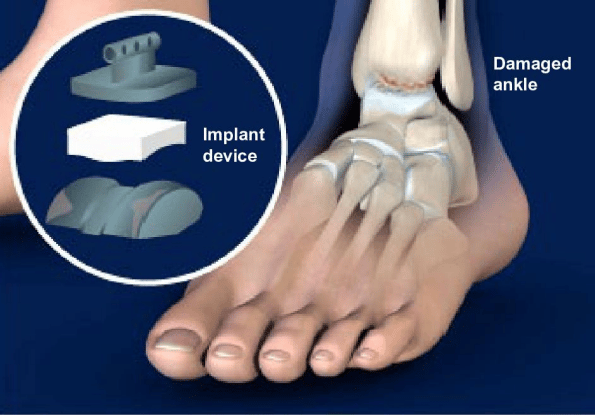Ankle Replacement Surgery
An ankle replacement procedure allows the surgeon to remove damaged or diseased parts of the ankle and replace them with an artificial ankle joint which consists of metal and plastic. The implant then helps reduce pain and increase mobility.
Symptoms
The Omaha Foot & Ankle Specialists at MD West ONE are able to properly diagnose a condition that may lead to an ankle replacement surgery. If you have the following symptoms, you may want to make an appointment with one of our Board Certified Specialists.
- Chronic ankle pain
- Disability or limited mobility in the ankle
- Advanced arthritis
- Weakness
- Instability
Why is my healthcare provider recommending an ankle replacement?
An ankle replacement is often used to treat severe arthritis causing inflammation, pain, and instability in the joint. Types of arthritis that may lead to an ankle replacement include:
- Osteoarthritis - Develops from wear and tear on your joints over time
- Post-traumatic arthritis - Occurs after a significant ankle injury such as a fracture
- Rheumatoid arthritis - An autoimmune disease that damages your joints
Before recommending surgery, though, your healthcare provider will try to treat your ankle arthritis with non-surgical options like:
- Activity modification like avoiding prolonged standing and walking
- Anti-inflammatory medications or topical treatments
- Corticosteroids injections
- Supportive devices including braces, a walker, a cane, etc.
- Physical therapy and exercise

Surgical Procedure
To begin the procedure, you are put under anesthesia, and the surgeon makes an incision in the front of the ankle. The ankle is inspected and then the surgeon prepares the joint for the implant by removing a portion of the talus and the tibia. In some cases, the surgeon may also have to remove a part of the fibula.
In the next step of the surgery, the surgeon inserts the artificial ankle which consists of three components: the talar, the tibial, and the plastic cup. The talar piece of the implant replaces the talus and the tibial replaces the end of the tibia. The plastic cup is then positioned between these two pieces so they can glide smoothly against each other.
Depending on your case, the surgeon may also need to fuse the fibula and tibia with a bone graft which helps them grow together. They could also use plates and screws to do this as well.
After the implant is in, the surgeon will test the ankle for mobility to ensure the components all fit together. Once this is confirmed, the surgeon can close up the incision.
Possible Complications and Risks of an Ankle Replacement Surgery
All surgeries carry some risk. For an ankle replacement, these include:
These include:
- Infection
- Damage to nearby nerves
- Bleeding or a blood clot
- Bones not joining together properly or misalignment
- Arthritis developing in neighboring joints
- Loosening of the artificial components, which might eventually need a follow-up surgery
Your own risk of complications may vary according to your age and your other medical conditions. Talk with your healthcare provider about all your concerns, including the risks most relevant to you.
Post Operative Care
Your ankle is immobilized and you are watched for a brief amount of time while the anesthesia wears off. You may have significant pain right after your surgery, but pain medicines may help ease the pain. The pain should begin to diminish over a few days, and you should have less pain than before your surgery. Most patients can go home the same day and your healthcare provider will give you tips to help you as you heal.
You will likely need to wear a splint for a couple of weeks after the surgery. You might also need to use crutches for several weeks. Your healthcare provider will give you instructions about how to move your foot while you recover. It may be helpful to rest and elevate your leg for the first week or so after your surgery. You won’t be able to put your full weight on your foot for a few months.
After the incision is healed, a cast or boot will be fitted on the ankle and it is often recommended to do physical therapy. This regimen typically starts two to four weeks after your ankle fracture surgery occurring two to three times per week. Your doctor will create the post-operative plan right for you, but often times physical therapy can continue for six to eight weeks.
Carefully following your healthcare provider’s instructions about rehabilitation, medicines, and wound care should increase your chances of a positive outcome.
When should you contact your healthcare provider or go to an emergency room?
You will have follow-up appointments with your surgeon to ensure you have the best possible outcome from the procedure. However, if you feel any of the following symptoms in between follow-up visits you should call your healthcare provider or seek medical attention as soon as possible.
- Your foot or toes are tingly, weak, or numb
- Your boot or cast feels too tight
- Your foot is cool or pale or changes color
- You are sick to your stomach or can't keep down fluids
- You have loose stitches, or your incision comes open
- You have signs of a blood clot in your leg like redness or swelling or a large bruise and pain on the back of your calf
- You have symptoms of infection, such as increased pain, swelling, warmth, or redness
Meet MD West ONE's foot and ankle specialists and learn more about how they treat Achilles tendon injury.
AMERICAN ORTHOPAEDIC FOOT & ANKLE SOCIETY
All of the foot and ankle surgeons in the practice are recognized members of the American Orthopaedic Foot & Ankle Society. It is the oldest and most prestigious medical society dedicated to the foot and ankle. The mission of the society is to advance science and practice of foot and ankle surgery through education, research, and advocacy on behalf of patients and practitioners. These physicians dedicate their time and energy to improving the patient experience and their knowledge in their field. For more information visit http://www.aofas.org.
MD West ONE Foot & Ankle Specialists:
The Foot & Ankle Specialists are all Board Certified and Fellowship-Trained, meaning they’ve focused their education, training and research on orthopaedic surgery of the foot and ankle.





